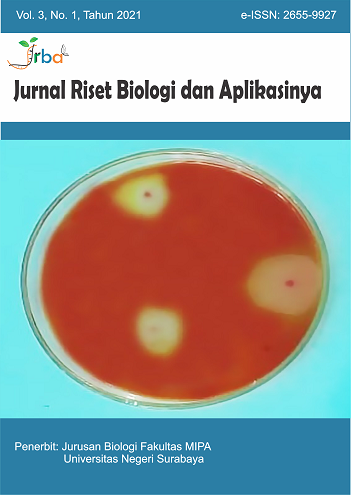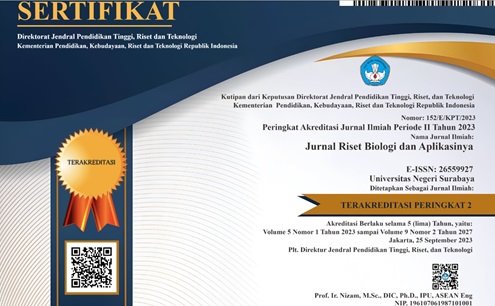Design of the env-su Gene Coding for Surface Unit Protein as a Vaccine Candidate for Jembrana Disease Virus in In Silico
DOI:
https://doi.org/10.26740/jrba.v3n1.p13-22Keywords:
Vaccine candidate, env-su gene, sequence alignment, codon optimization, in silicoAbstract
Bali cattle are superior meat producers, but they are susceptible to Jembrana disease. The injection of the crude vaccine was considered ineffective, so the env-su gene was selected to express the Jembrana Surface Unit (JSU) protein as a candidate for the Jembrana vaccine. This study aimed to analyze the potential of the JSU protein as a candidate for the Jembrana vaccine and analyze the increase in the env-su gene expression which codon has been optimized in silico. Vaccine design was carried out through in silico including the selection of the SU protein sequences of the genus Lentivirus and sequence alignment of UniProt. The construction phylogeny tree of SU protein using MEGA-X program, optimization of env-su gene codon with preference codon Esherichia coli str. K-12 substr. MG1655 using Optimizer. The optimized env-su gene was inserted into the plasmid pET-21a (+) using GenScript. The result of sequence alignment showed that there is no SU protein that has a percent identity value of more than 30% with JSU protein. The SU JDV and BIV proteins are monophyletic groups and have a percent identity of 20.57%. Codon optimization showed an increase in CAI by 1,000 and GC 54.5%, and a decrease in ENc to 22 and AT 45.5%. EcoR1 and HindIII can recognize the gene target and MCS cut regions on the plasmid so that the env-su gene can be inserted into the pET-21a (+) plasmid. The JSU protein has the potential to be a candidate for the Jembrana vaccine, but it needs further research in vitro and in vivo.
References
Ali, M. (2015). Upaya Pengembangan Teknologi Cepat Transkripsi dan Translasi In Vitro dalam Sintesis Vaksin di Indonesia. Wartazoa, 25(4), 181188. Retrieved from https://onesearch.id/Record/IOS5428.18465.
Aryadrie, D. fitria, Santosa, P. E., & Suharyanti, S. (2015). Tingkat Infestasi Cacing Hati pada Sapi Bali di Kecamatan Sukoharjo Kabupaten Pringsewu Provinsi Lampung. Jurnal Ilmiah Peternakan Terpadu, 3(3), 134139. http://dx.doi.org/10.23960/jipt.v3i3.p%25p.
Astiti, N. M. A. G. R. (2018). Sapi Bali dan Pemasarannya. Warmadewa University Press.
Barahimipor, R., Strenkert, D., Neupert, J., Schroda, M., Merchant, S. S., & Bock, R. (2015). Dissecting the Contributions of GC Content and Codon Usage to Gene Expression in the Model Alga Chlamydomonas reinhardtii. Plant Journal, 84(4), 704717. doi: 10.1111/tpj.13033.
Bartak, P., Simek, B., Vaclavek, P., Curn, V., Plodkova, H., Tonka, T., Farková, B., Vernerová, K., & VejÄÃk, A. (2018). Genetic Characterisation of Small Ruminant Lentiviruses in Sheep and Goats from The Czech Republic. Acta Veterinaria Brno, 87(1), 1926. https://doi.org/10.2754/avb201887010019.
Behura, S. K., & Severson, D. W. (2012). Comparative Analysis of Codon Usage Bias and Codon Context Patterns between Dipteran and Hymenopteran Sequenced Genomes. Plos One, 7(8), 111. doi: 10.1371/journal.pone.0043111.
Buulolo, I. C., Simamora, N., Tampubolon, S., & Pinem, A. (2010). Sequence Alignment Menggunakan Algoritma Smith Waterman. Seminar Nasional Politeknik Batam, 2(2), 27. Retrieved from https://jurnal.polibatam.ac.id/index.php/JI/article/view/256.
Choiriyah, U., Nurjayadi, M., & Dewi, F. K. (2013). Subkloning dan Ekspresi Gen Fim-C S. Typhimurium. Jurnal Riset Sains Dan Kimia Terapan, 3(2), 280291. https://doi.org/10.21009/JRSKT.032.01.
Courel, M., Clément, Y., Bossevain, C., Foretek, D., Cruchez, O. V., Yi, Z., Bénard, M., Benassy, M. N., Kress, M., Vindry, C., Ernoult-Lange, M., Antoniewski, C., Morillon, A., Brest, P., Hubstenberger, A., Crollius, H. R., Standart, N., & Weil, D. (2019). Gc Content Shapes mRNA Storage and Decay in Human Cells. ELife, 8, 132. Retriefed from https://elifesciences.org/articles/49708.
Daugelaite, J., O Driscoll, A., & Sleator, R. D. (2013). An Overview of Multiple Sequence Alignments and Cloud Computing in Bioinformatics. International Scholarly Research Notices, 2013, 114. https://doi.org/10.1155/2013/615630.
Ernawati, E., Puspitaningrum, D., & Pravitasari, A. (2014). Implementasi Algoritma SmithWaterman Pada Local Alignment Dalam Pencarian Kesamaan Pensejajaran Barisan DNA (Studi Kasus: DNA Tumor Wilms). Jurnal Pseudocode,1(2), 170177). https://doi.org/10.33369/pseudocode.1.2.170-177.
GenScript. (2019). Gene Synthesis Handbook (4th ed). GenScript USA Inc.
Glick, B. R., Pasternak, J. ., & Patten, C. (2010). Molecular Biotechnology: Principles and Applications of Recombinant DNA (4th ed). ASM Press.
Gun, L., Yumiao, R., Haixian, P., & Liang, Z. (2018). Comprehensive Analysis and Comparison on The Codon Usage Pattern of Whole Mycobacterium tuberculosis Coding Genome from Different Area. Biomed Research International, 2018(2), 18. https://doi.org/10.1155/2018/3574976.
Gustiananda, M. (2011). Immunoinformatics Analysis of H5N1 Proteome for Designing an Epitope-derived Vaccine and Predicting the Prevalence of Pre-existing Cellular-mediated Immunity Toward Bird Flu Virus in Indonesian Population. Immunome Research, 7(3), 111. Retrieved from https://www.longdom.org/abstract/immunoinformatics-analysis-of-h5n1-proteome-for-designing-an-epitopederived-vaccine-and-predicting-the-prevalence-of-pre-8638.html.
Indriawati, I., Margawati, E. T., & Ridwan, M. (2013). Identifikasi Virus Penyakit Jembrana pada Sapi Bali Menggunakan Penanda Molekuler Gen env SU. Berita Biologi, 12(2), 211216. doi: 10.14203/beritabiologi.v12i2.534.
Kusumaningsih, P. (2018). Evaluasi Konstruksi DNA Da+Lam Vektor Plasmid Berkaitan dengan Ekspresi Protein Rekombinan Rophtry-1 (ROP1) Toxoplasma Gondii pada Eschericia coli. Universitas Dhyana Pura Bali.
Kusumawati, A., Tampubolon, I. D., Hendarta, N. Y., Salasia, S. I. O., Wanahari, T. A., Mappakaya, B. A., & Hartati, S. (2015). Use of Reverse Transcription Loop-mediated Isothermal Amplification Combined with Lateral Flow Dipstick for an easy and Rapid Detection of Jembrana Disease Virus. Virus Disease, 26(3), 189195. doi: 10.1007/s13337-015-0277-5.
Kusumawati, A., Wanahari, T. A., Putri, R. F., Mappakaya, B. A., & Tampubolon, I. D. (2014). The Structure and Function of Jembrana Disease Virus Genome. Journal of Infection and Molecular Biology, 2(2), 2629. Retrieved from https://www.ncbi.nlm.nih.gov/pmc/articles/PMC103872/.
Lanza, A. M., Curran, K. A., Rey, L. G., & Alper, H. S. (2014). A Condition-Specific Codon Optimization Approach for Improved Heterologous Gene Expression in Saccharomyces cerevisiae. BMC Systems Biology, 8(1), 110.
Liu, B., Kong, Q., Zhang, D., & Yan, L. (2018). Codon Optimization Significantly Enhanced the Expression of Human 37-kDa iLRP in Escherichia coli. 3 Biotech, 8(4), 17. doi: 10.1007/s13205-018-1234-y.
Maksum, I. P., Utama, E., & Subroto, T. (2017). Extracellular Secretion of Recombinant Human Epidermal Growth Factor by Using Trimethylamine N-Oxide Reductase A (TORA) Signal Peptide in Escherichia Coli BL21 (DE3). Jouranl of Pharmaceutical Sciences and Research, 9(6), 10071016.
Retrieved from https://www.jpsr.pharmainfo.in/Documents/Volumes/vol9Issue06/jpsr09061746.pdf.
Maksum, I., Sriwidodo, & Yosua. (2019). Strategi Peningkatan Ekspresi Protein Rekombinan Secara Intraselular pada Inang Escherichia coli. Universitas Padjajaran.
Mardiatmi, M. (2015). Pedoman Pengendalian dan Penanggulangan Penyakit Jembrana. Direktorat Kesehatan Hewan.
Mauro, V. P., & Chappell, S. A. (2014). NIH Public Access. Trends in Molecular Medicine, 20(11), 604613.
Mega, O., Sumantri, C., Arief, I. I., & Budiman, C. (2019). Ekspresi Gen Lon-like Protease dari Lactobacillus plantarum IIA-1A5 pada Escherichia coli BL21(DE3). Jurnal Agripet, 19(2), 149158. https://doi.org/10.17969/agripet.v19i2.14904.
Milo, R. (2017). BioNumbers-GC Content of E. coli K12 Chromosome. Nucleic Acids Research, ID 100528.
Nurjayadi, M., Afrizal, R., Hardianto, D., & Agustini, K. (2019). Variations of Binding, Washing, and Concentration of Imidazole on Purification of Recombinant Fim-C Protein Salmonella typhi with Ni-NTA Resin. Journal of Physics: Conference Series, 1402(2019), 17. https://doi.org/10.1088/1742-6596/1402/5/055055.
Pangestika, Y., Budiharjo, A., & Kusumaningrum, H. P. (2015). Analisis Filogenetik Curcuma zedoaria (Temu Putih) Berdasarkan Gen Internal Transcribed Spacer (ITS). Jurnal Biologi, 4(4), 813. Retrieved from https://ejournal3.undip.ac.id/index.php/biologi/article/view/19424.
Pearson, W. R. (2013). An Introduction to Sequence Similarity (œHomology) Searching. Current Protocols Bioinformatics, 42(1), 19. doi: 10.1002/0471250953.bi0301s42.
Priyatno, T. P., Winangsih, F., Manzila, I., & Bintang, M. (2019). Ekspresi dan Karakterisasi β-1,3-Glukanase Rekombinan dari Burkholderia cepacia (BiogenCC E76) yang Diekspresikan dalam Sistem Ekspresi Escherichia coli. Jurnal AgroBiogen, 15(1), 3544.
Ramadhani, D., & Suvifan, V. A. (2012). Aplikasi Teknik C-Banding sebagai Biodosimetri Radiasi. Buletin Alara, 14(1), 1722.
Retnaningati, D. (2017).Hubungan Filogenetik Intraspesies Cucumis melo L. berdasarkan DNA Barcode Gen matK. Biota, 2(2), 6267. https://doi.org/10.24002/biota.v2i2.1658.
Rosano, G. L., & Ceccarelli, E. A. (2014). Recombinant Protein Expression in Escherichia coli: Advances and Challenges. Frontiers in Microbiology, 5(172), 117. https://doi.org/10.3389/fmicb.2014.00172.
Shirasawa, K., Hirakawa, H., & Isobe, S. (2016). Analytical Workflow of Double-Digest Restriction Site-Associated DNA Sequencing based on Empirical and In Silico Optimization in Tomato. DNA Research, 23(2), 145153. doi: 10.1093/dnares/dsw004.
Silaban, S., Maksum, I. P., Enus, S., Hasan, K., Subroto, T., & Soemitro, S. (2016). Kajian Ekspresi Gen Pretrombin-2 Manusia Sintetik pada Escherichia coli Secara In Silico Untuk Produksi Trombin sebagai Komponen Lem Fibrin. Jurnal Pendidikan Kimia, 8(1), 5864. https://doi.org/10.24114/jpkim.v8i1.4425.
Silaban, S., Maksum, I. P., Gaffar, S., Enus, S., Hasan, K., Subroto, T., & Soemitro, S. (2017). Desain, Optimasi, dan Kloning Gen Pretrombin-2 sintetik untuk Produksi Trombin sebagai Komponen Lem Fibrin. Jurnal Ilmiah Ilmu Dan Teknologi Kimia, 1(1), 6981. Retrieved from http://stakc.ac.id/2017/08/12/desain-optimasi-dan-kloning-gen-pretrombin-2-sintetik-untuk-produksi-trombin-sebagai-komponen-lem-fibrin/.
Sunarto, A. A. (2015). Perbandingan Program Sequence Alignment. Jurnal Rekayasa Nusaputra, 1(1), 15. Retrieved from https://jurnal.nusaputra.ac.id/rekayasa/uploads/paper/55ed4-asril-adi-sunarto.pdf.
Susmiarsih, T. P. (2018). Kajian DNA Rekombinan pada Vaksin DNA dan Vaksin Subunit Protein. Majalah Kesehatan Pharma Medika, 10(2), 108128.
Thenawidjaja, M., Ismaya, W. T., & Retnoningrum, D. S. (2017). Protein; Serial Biokimia Mudah dan Menggugah. Grasindo.
Uddin, A. (2017). Indices of Codon Usage Bias. Journal of Proteomics & Bioinformatics, 10(6), 4172. Retrieved from https://www.longdom.org/open-access/indices-of-codon-usage-bias-jpb-1000e34.pdf.
Ullah, M. A., Sarkar, B., & Islam, S. S. (2020). Exploiting the Reverse Vaccinology Approach to Design Novel Subunit Vaccines Against Ebola Virus. Immunobiology, 225(3), 180. https://doi.org/10.1016/j.imbio.2020.151949.
Wang, Y., Cao, X., Zhao, Y., Fei, J., Hu, X., & Li, N. (2017). Optimized Double-Digest Genotyping by Sequencing (ddGBS) Method with Highdensity SNP Markers and High Genotyping Accuracy for Chickens. PLoS ONE, 12(6), 119. https://doi.org/10.1371/journal.pone.0179073.
Yang, X., Chen, B., Cai, Y., & Tseng, C. (2015). Understanding The Lac Operon with GeneAct. International Journal of Computational Biology and Drug Design, 8(2), 168188. doi: 10.1504/IJCBDD.2015.071127.
Yulita, D. S., Polosoro, A., Sisharmini, A., Apriana, A., Nurilmala, F., & Trijatmiko, R. (2020). Konstruksi Vektor Biner dan Transformasi Gen LcCsp Sintetis ke dalam Genom Padi Nipponbare dengan Bantuan Agrobacterium tumefaciens. Jurnal AgroBiogen, 16(1), 2534. Retrieved from http://ejurnal.litbang.pertanian.go.id.
Zhou, H., Ning, L., Zhang, H., & Guo, F. (2014). Analysis of the Relationship between Genomic GC Content and Patterns of Base Usage , Codon Usage and Amino Acid Usage in Prokaryotes¯: Similar GC Content Adopts Similar Compositional Frequencies Regardless of the Phylogenetic Lineages. Plos One, 9(9), 17. https://doi.org/10.1371/journal.pone.0107319.
Downloads
Additional Files
Published
How to Cite
Issue
Section
 Abstract views: 698
,
Abstract views: 698
, PDF Downloads: 978
,
PDF Downloads: 978
, PDF Downloads: 0
PDF Downloads: 0












